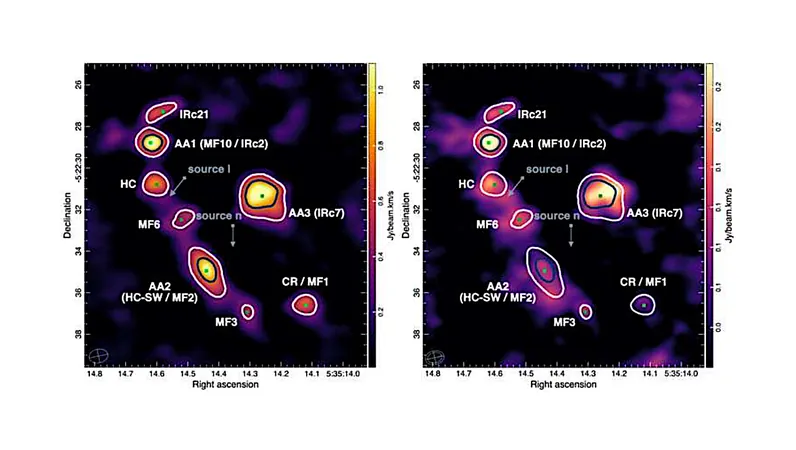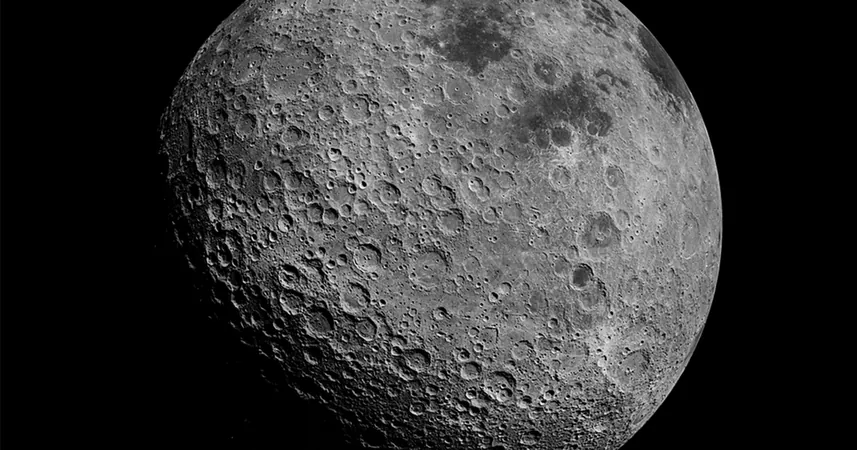
Unveiling the Secrets of Acetaldehyde in Orion KL: Groundbreaking ALMA Discoveries Reveal Hidden Chemistry!
2025-03-27
Author: Sarah
Introduction
In a groundbreaking study, scientists have finally put their focus on acetaldehyde (CH3CHO), one of the most commonly found interstellar aldehydes, which had eluded firm identification through millimeter-wave interferometry in the Orion KL region—an area teeming with organic molecules.
Methodology
Using extensive datasets from the Atacama Large Millimeter/submillimeter Array (ALMA), which covers frequencies ranging from 142 to 355 GHz, researchers unearthed two prominent emission peaks of acetaldehyde and an additional component exhibiting complex kinematic structures.
Findings
Intriguingly, one peak is situated in the MF10/IRc2 region, noted for seldom-hosting emissions of other oxygen-bearing complex organic molecules. Conversely, the second peak correlates with the presence of ethanol in the hot core-SW, hinting at a fascinating interconnection between these organic species.
The detection at MF10/IRc2 suggests a unique chemical environment possibly driven by cycles of heating events, indicating that this area of Orion KL could host distinct chemical pathways.
The simultaneous detection of acetaldehyde and ethanol points towards origins from ices, thus raising the question of their potential interlinked chemistry in these extraterrestrial locales.
Data Analysis
To deepen the analysis, scientists calculated acetaldehyde column densities and estimated its kinetic temperatures at these emission peaks. Hoping to unveil the chemical relationships between various molecules, they meticulously compared acetaldehyde's distribution with that of ethanol and other aldehyde-bearing compounds, including methyl formate, glycolaldehyde, and formic acid.
Chemical Modeling
A sophisticated chemical model has produced fascinating insights: Firstly, it posits that the breakdown of ethanol might generate acetaldehyde from icy sources, thus reinforcing the observed correlation between the two. Secondly, it appears that a prolonged cold-collapse period and a binding energy for methyl formate comparable to or lower than that of water are critical to explain the observations made.
Conclusion
Significantly, the study found that ratios of these aldehyde-bearing species are highly sensitive to the kinetic temperature, contributing to the striking spatial variability of the aldehyde ratios observed in the intricate environment of Orion KL.
This pivotal research not only enhances our understanding of organic chemistry in space but also opens new avenues for exploring how complex molecules form and evolve in the universe.
As we unravel these celestial mysteries, who knows what other secrets lie within the stars? Keep your eyes on the skies—great discoveries await!
Acknowledgments
This study was executed by a team of renowned scientists including Miwha Jin, Anthony J. Remijan, Robin T. Garrod, Giseon Baek, Martin Cordiner, Steven Charnley, Eric Herbst, and Jeong-Eun Lee, pushing the boundaries of our knowledge on cosmic chemistry.



 Brasil (PT)
Brasil (PT)
 Canada (EN)
Canada (EN)
 Chile (ES)
Chile (ES)
 Česko (CS)
Česko (CS)
 대한민국 (KO)
대한민국 (KO)
 España (ES)
España (ES)
 France (FR)
France (FR)
 Hong Kong (EN)
Hong Kong (EN)
 Italia (IT)
Italia (IT)
 日本 (JA)
日本 (JA)
 Magyarország (HU)
Magyarország (HU)
 Norge (NO)
Norge (NO)
 Polska (PL)
Polska (PL)
 Schweiz (DE)
Schweiz (DE)
 Singapore (EN)
Singapore (EN)
 Sverige (SV)
Sverige (SV)
 Suomi (FI)
Suomi (FI)
 Türkiye (TR)
Türkiye (TR)
 الإمارات العربية المتحدة (AR)
الإمارات العربية المتحدة (AR)